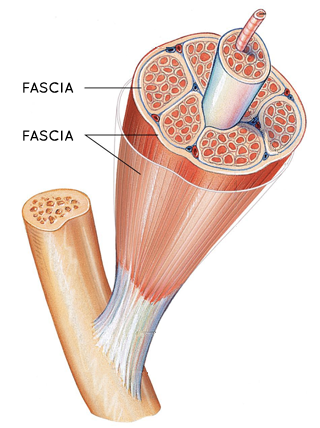Fascia is a thin sheath of fibrous tissue enclosing muscles or other organs. An easier way to visualize how fascia works in our bodies is to think of it as an intricate web. As a web, our fascial system is uninterrupted and runs from head to toe. This dense tissue covers every muscle, bone, nerve, as well as all other soft tissues in the body which include all of our organs and even arteries and veins. Our fascia is essentially responsible for holding our bodies together.
Knowing what and how fascia works in our bodies, it will now be easier to understand why fascia and pain are connected. Fascia can tighten and form adhesions acting like a buildup of scar tissue in our muscles or ligaments. When our bodies move, the fascia may squeeze nerves and vessels, creating pain or discomfort. Sometimes, this means pain can be felt at a site other than the place of energy. This is commonly known as "referred pain." For example, the physical therapist may apply pressure to your trapezius (or trapezoid) and you would feel pain in your head. If we think of fascia as a web, it is easy to visualize how pressing on one part of a web may cause other parts to stretch, pull or twist.
Here is a list of a few simple techniques that may help with your fascia pain.
- HYDRATE: This helps keep tissue lubricated and pliable.
- MOVE FREQUENTLY: Don't sit in one place too long as this can cause fascia and muscles to get stuck in one position.
- STRETCH GENTLY: Try stretching your arms and legs out and gently rolling from side to side before you get out of bed in the morning.
- USE A FOAM ROLLER: If haven't used one of these before, a physical therapist can help you to learn how to use it correctly.
- WARM UP BEFORE YOU EXERCISE: Do some range of motion or dynamic stretching, such as arm swings and shoulder rolls before you begin.
Trapezius
A flat, triangle-shaped muscle in your back that extends from your neck, down along the spine to about the middle of your back and across your shoulder blade. You have two trapezii: a right and left trapezius, which support your arms and shoulders and are the muscles used to raise your arms.


